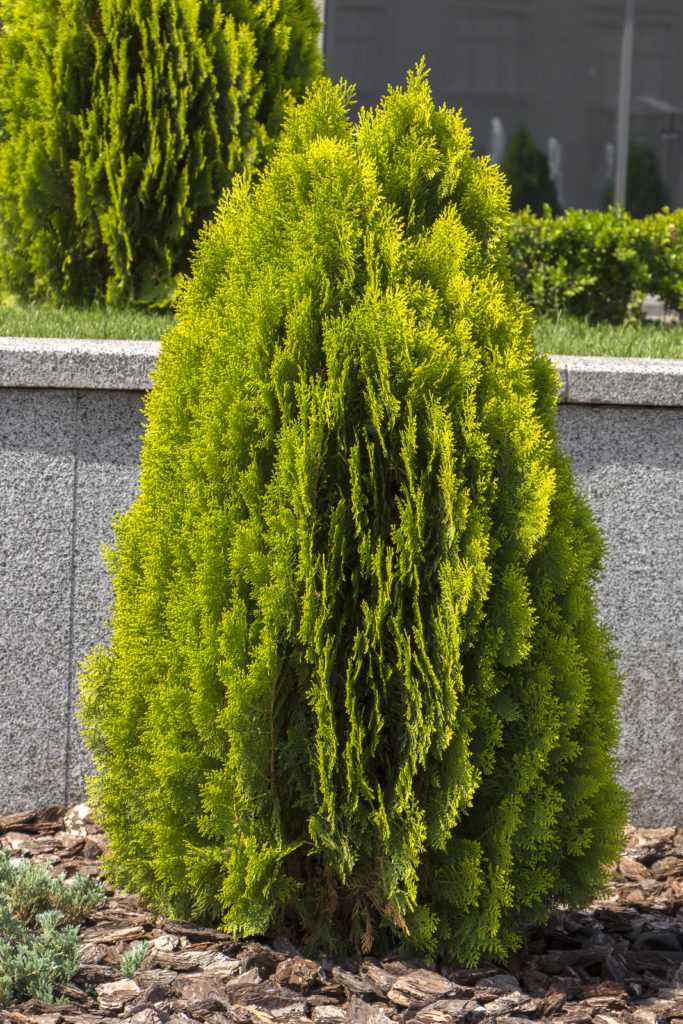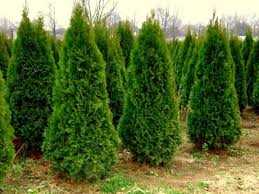- What is Thuja?
- Description
- Types and Varieties
- Propagation
- Uses
- Care and Maintenance
- Why Grow Thuja?
- Growing Thuja
- 1. Planting
- 2. Watering
- 3. Pruning
- 4. Fertilizing
- 5. Mulching
- 6. Winter Care
- Planting Thuja
- 1. Choosing a Location
- 2. Preparing the Soil
- 3. Digging the Planting Hole
- 4. Planting the Thuja
- 5. Watering and Mulching
- 6. Care and Maintenance
- Caring for Thuja
- Watering
- Pruning
- Fertilizing
- Mulching
- Winter Protection
- Pest and Disease Control
- Growing Conditions
- Propagation of Thuja
- 1. Propagation from Seeds
- 2. Propagation from Cuttings
- 3. Propagation by Layering
- Methods of Propagation
- Tips for Successful Propagation
- Types and Varieties of Thuja
- 1. Thuja occidentalis
- 2. Thuja plicata
- 3. Thuja standishii
- 4. Thuja koraiensis
- 5. Thuja orientalis
- 6. Thuja x ‘Green Giant’
- 7. Thuja x ‘Danica’
- 8. Thuja x ‘Spiralis’
- Common Types of Thuja
- Thuja occidentalis (American Arborvitae)
- Thuja plicata (Western Red Cedar)
- Thuja orientalis (Oriental Arborvitae)
- Thuja koraiensis (Korean Arborvitae)
- Questions and Answers:
- What is Thuja and what are its uses?
- How do you grow Thuja?
- What are the different types and varieties of Thuja?
- Is Thuja resistant to pests and diseases?
- How fast does Thuja grow?
- Videos: How to Grow Cuttings of Thuja at home most easily with 100% Sure Success
Thuja, also known as arborvitae, is a popular evergreen tree that is widely grown for its ornamental value and practical uses. With its beautiful foliage and impressive size, Thuja is often used as a hedge or screen to provide privacy and block out unwanted sights and sounds.
One of the most attractive features of Thuja is its fast growth rate. It can reach a height of 40 feet or more in just a few years, making it an excellent choice for those who want a tall, dense hedge or screen in a short amount of time. Thuja is also known for its resistance to various pests and diseases, making it a low-maintenance option for gardeners.
Propagation of Thuja can be done through various methods, including seeds, cuttings, and division. However, the most common method is through cuttings, as it is relatively easy and reliable. Taking cuttings from a healthy Thuja tree and planting them in a suitable potting mix can result in new plants that are genetically identical to the parent tree.
There are several types and varieties of Thuja available, each with its own unique characteristics. Some popular types include Thuja occidentalis (also known as American arborvitae), Thuja plicata (also known as Western red cedar), and Thuja orientalis (also known as Oriental arborvitae). Each type has its own growth habit, foliage color, and size, allowing gardeners to choose the perfect Thuja for their needs.
Whether you’re looking to add a beautiful evergreen tree to your landscape or need a fast-growing hedge for privacy, Thuja is an excellent choice. With its ease of propagation and wide variety of types and varieties, there is a Thuja tree out there to suit every gardener’s preferences and needs.
What is Thuja?
Thuja is a genus of evergreen coniferous trees and shrubs belonging to the cypress family Cupressaceae. It is native to North America and East Asia and is widely cultivated for its ornamental and landscaping purposes.
The common name for Thuja is arborvitae, which means “tree of life” in Latin. This name reflects the long lifespan and resilience of these trees.
Description
Thuja trees are typically tall, reaching heights of 30 to 60 feet. They have a conical or columnar shape and dense foliage that creates a natural privacy screen or windbreak. The foliage is scale-like and arranged in flattened sprays. The color of the foliage varies among different species and varieties, ranging from green to golden-yellow.
Thuja trees also produce small cones that contain winged seeds. These cones are often inconspicuous and do not have significant ornamental value.
Types and Varieties
There are several species and varieties of Thuja, including:
- Thuja occidentalis: Also known as American arborvitae or white cedar, this species is native to North America and is a popular choice for hedges and screens.
- Thuja plicata: Commonly known as western red cedar, this species is native to the Pacific Northwest and is known for its large size and strong wood.
- Thuja orientalis: Also called oriental arborvitae, this species is native to East Asia and is often used for landscaping and as a bonsai tree.
Propagation
Thuja can be propagated through various methods, including:
- Seeds: Collect seeds from mature cones and sow them in a well-draining soil mix. Keep the soil moist until germination occurs.
- Cuttings: Take 4-6 inch cuttings from the current season’s growth. Remove the lower leaves and dip the cut end in rooting hormone. Plant the cuttings in a well-draining soil mix and keep them in a warm and humid environment until roots develop.
- Layering: Bend a low-hanging branch to the ground and bury a portion of it in the soil. Keep the buried portion moist until roots develop, then sever the branch from the parent plant.
Uses
Thuja trees are commonly used for landscaping purposes, such as hedges, screens, and windbreaks. Due to their dense foliage and upright growth habit, they provide excellent privacy and noise reduction. Thuja trees are also suitable for container gardening and can be shaped into different forms through pruning.
In addition to their ornamental value, Thuja trees also have medicinal properties. The essential oil extracted from Thuja is used in traditional medicine for its antifungal and antiviral properties. It is also used in beauty products for its skin-beneficial properties.
Care and Maintenance
Thuja trees are relatively low-maintenance and can adapt to various soil conditions. They prefer well-draining soil and full sun to partial shade. Regular watering is necessary, especially during the first few years of growth. Pruning can be done to maintain the desired shape and size. Pests such as aphids and bagworms can occasionally infest Thuja trees, but they can be controlled with appropriate measures.
In conclusion, Thuja is a versatile and popular evergreen tree that offers both aesthetic and practical benefits. Whether used for landscaping, medicinal purposes, or simply enjoyed for its beauty, Thuja is a valuable addition to any garden or landscape.
Why Grow Thuja?
Thuja, commonly known as arborvitae or cedar, is a versatile and attractive evergreen tree that has many benefits for gardeners and homeowners. Here are a few reasons why you should consider growing Thuja:
- Ornamental Value: Thuja trees have a graceful and elegant appearance, making them a popular choice for landscaping and creating a focal point in the garden.
- Privacy Screen: Thuja trees grow densely and can be easily shaped and pruned to form a tall hedge or privacy screen. They provide year-round privacy, noise reduction, and create a natural barrier against wind and dust.
- Low Maintenance: Thuja trees are relatively low maintenance and can adapt to a wide range of soil conditions and climate zones. They are resistant to pests and diseases, making them a hassle-free choice for gardeners.
- Fast Growth: Thuja trees are known for their fast growth rate. Some varieties can grow up to 3 feet per year, allowing you to quickly establish a lush green hedge or screen.
- Cold Tolerance: Thuja trees are cold-hardy and can withstand harsh winter conditions, making them an excellent choice for gardens in colder regions.
- Wildlife Habitat: Thuja trees provide a valuable habitat for birds and small animals. The dense foliage and branches offer shelter and nesting sites, while the small cones provide a source of food.
Overall, Thuja is a versatile and attractive tree that offers numerous benefits for gardeners, homeowners, and wildlife. Whether you want to create a privacy screen, add beauty to your landscape, or provide a habitat for wildlife, Thuja is an excellent choice.
Growing Thuja
Thuja is a popular evergreen shrub that is known for its dense foliage and conical shape. It is a relatively low-maintenance plant that can be easily grown in a variety of conditions. Here are some tips for successfully growing Thuja:
1. Planting
Choose a location that receives full sun to partial shade. Thuja can tolerate a wide range of soil types but prefers well-draining soil. Dig a hole that is two times wider and slightly deeper than the root ball of the plant. Place the plant in the hole and backfill with soil, firming it gently around the root ball. Water thoroughly after planting.
2. Watering
Provide regular watering during the first year of growth to help the roots establish. After the first year, Thuja is generally drought-tolerant and only requires supplemental watering during dry periods. Water deeply and less frequently to encourage deep root growth.
3. Pruning
Pruning is not necessary for Thuja, but it can be done to maintain a desired shape or size. If you choose to prune, do so in early spring before new growth begins. Avoid cutting into old wood, as Thuja does not regenerate foliage on old branches.
4. Fertilizing
Thuja generally does well without fertilization, but if you want to promote faster growth, you can apply a balanced slow-release fertilizer in early spring. Follow the package instructions for application rates.
5. Mulching
Applying a layer of mulch around the base of the plant can help conserve soil moisture and suppress weed growth. Use organic mulch such as wood chips or bark, and apply a layer that is 2-3 inches thick. Avoid piling the mulch against the trunk of the plant.
6. Winter Care
Thuja is a cold-hardy plant and does not require special care during the winter months. However, if you live in an area with harsh winters and heavy snowfall, you can wrap the plant in burlap to protect it from snow and wind damage.
By following these tips, you can successfully grow Thuja and enjoy its beauty in your garden for years to come.
Planting Thuja
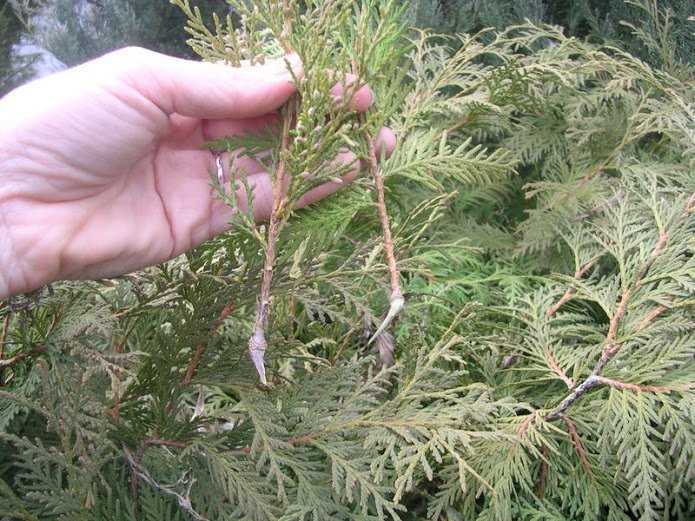
Thuja is a popular evergreen shrub that is commonly used in landscaping due to its attractive foliage and versatility. Whether you are a beginner or experienced gardener, planting Thuja is relatively easy and can be done successfully with a few simple steps.
1. Choosing a Location
The first step in planting Thuja is to choose the right location. Thuja is a sun-loving plant that thrives in full sun to partial shade. It prefers well-draining soil, so make sure to choose a location that provides good drainage. Avoid areas with heavy clay soil or locations that tend to hold water.
2. Preparing the Soil
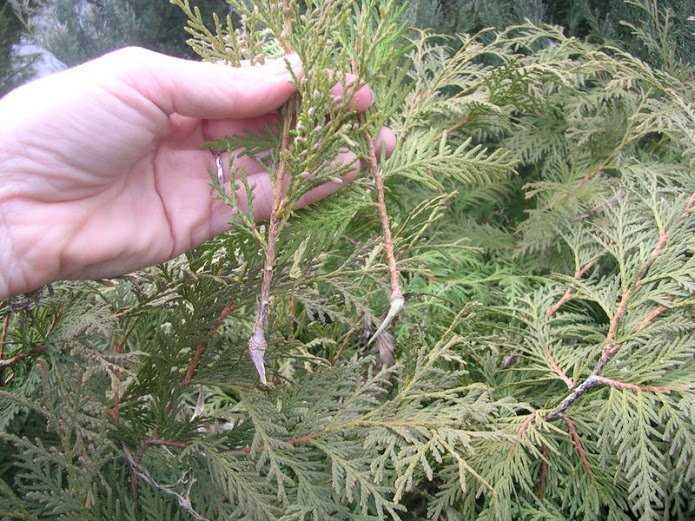
Before planting your Thuja, it is essential to prepare the soil properly. Start by removing any weeds or grass from the planting area. Loosen the soil using a garden fork or tiller and amend it with organic matter, such as compost or peat moss, to improve drainage and fertility.
3. Digging the Planting Hole
Next, dig a planting hole that is slightly wider and deeper than the root ball of the Thuja. The hole should be large enough to accommodate the roots without crowding or bending them. If you are planting multiple Thuja plants, space them according to the specific variety’s mature size, usually about 3 to 6 feet apart.
4. Planting the Thuja
After digging the planting hole, carefully remove the Thuja from its container and gently loosen the roots from the root ball. Place the Thuja in the hole, making sure that it is planted at the same depth it was previously growing. Backfill the hole with soil, firming it gently around the roots to eliminate any air pockets.
5. Watering and Mulching
After planting, water the Thuja thoroughly to settle the soil and provide moisture to the roots. Water deeply and regularly, especially during the first growing season, to help establish a healthy root system. Apply a layer of mulch around the base of the Thuja to conserve moisture, suppress weeds, and insulate the roots from extreme temperatures.
6. Care and Maintenance
Thuja is a low-maintenance plant, but it still requires some care to ensure its optimal growth and health. Regularly water the Thuja during dry periods and fertilize it annually with a balanced, slow-release fertilizer. Prune the Thuja as needed to maintain its desired shape and size, removing any dead or damaged branches.
By following these simple steps, you can successfully plant and grow Thuja in your garden or landscape. With its attractive foliage and versatility, Thuja can add beauty and greenery to any outdoor space.
Caring for Thuja
Watering
Thuja plants require regular watering, especially during dry periods. Water deeply and thoroughly, ensuring that the soil is evenly moist. Avoid overwatering, as Thuja prefers well-draining soil. Watering should be reduced during the winter months.
Pruning
Pruning helps maintain the desired shape and size of Thuja plants. It is best to prune in late winter or early spring before new growth appears. Remove any dead, damaged, or diseased branches. Trimming the tips of the branches can help promote bushier growth.
Fertilizing
Thuja trees and shrubs benefit from regular fertilization. Use a balanced, slow-release fertilizer in early spring. Follow the package instructions for application rates. It is important not to over-fertilize, as this can lead to excessive growth and weak branches.
Mulching
Mulching helps retain moisture and suppress weed growth around Thuja plants. Apply a layer of organic mulch, such as wood chips or bark, around the base of the plant. Maintain a mulch layer of 2-3 inches, taking care to keep the mulch away from the trunk to prevent rot.
Winter Protection
Some Thuja varieties may require protection during the winter months, especially in areas with harsh winters. Consider wrapping the plants with burlap or using anti-desiccant sprays to protect them from strong winds and extreme cold. Provide additional insulation by applying a layer of mulch around the base of the plant.
Pest and Disease Control
Monitor Thuja plants for any signs of pests or diseases. Common pests include bagworms, spider mites, and aphids. If a pest infestation occurs, promptly treat the affected plants with an appropriate insecticide or insecticidal soap. Be cautious when using chemicals and follow the instructions carefully.
- Common Pests: Bagworms, spider mites, aphids
- Common Diseases: Needle blight, root rot, canker
- Treatment: Insecticide or insecticidal soap for pests; fungicide for diseases
Growing Conditions
Thuja plants thrive in full sun to partial shade. They prefer well-draining soil with a slightly acidic to neutral pH. Avoid planting them in areas prone to standing water or waterlogged soil. Provide adequate air circulation around the plants to prevent fungal diseases.
| Light | Soil | Watering | Temperature |
|---|---|---|---|
| Full sun to partial shade | Well-draining, slightly acidic to neutral pH | Regular, deep watering | Hardy to USDA zones 2-9, depending on the variety |
Propagation of Thuja
Thuja can be propagated through several methods, including:
- Seeds
- Cuttings
- Layering
1. Propagation from Seeds
Propagation from seeds is the most common method for Thuja. Here is a step-by-step guide:
- Collect mature Thuja cones in late summer or early fall.
- Place the cones in a paper bag and allow them to dry for several weeks.
- Once the cones are dry, gently shake the bag to release the seeds.
- Separate the seeds from any remaining debris.
- Fill a seed tray or small pots with a well-draining potting mix.
- Place the seeds on the surface of the soil and lightly press them in.
- Mist the soil with water to keep it moist.
- Keep the tray or pots in a warm location with indirect sunlight.
- Germination can take several weeks to several months.
2. Propagation from Cuttings
Propagation from cuttings is another common method for Thuja. Here is a step-by-step guide:
- Select a healthy branch from an established Thuja plant.
- Cut a 4-6 inch stem from the branch, just below a node.
- Remove the lower leaves from the stem, leaving only the topmost few.
- Dip the cut end of the stem in rooting hormone.
- Fill a pot with a well-draining potting mix.
- Make a hole in the soil with a pencil or finger.
- Insert the cutting into the hole and firm the soil around it.
- Mist the soil with water to keep it moist.
- Keep the pot in a warm location with indirect sunlight.
- Rooting can take several weeks to several months.
3. Propagation by Layering
Propagation by layering is a less commonly used method for Thuja. Here is a step-by-step guide:
- Select a low, flexible branch from an established Thuja plant.
- Make a small wound on the underside of the branch where it touches the ground.
Propagation of Thuja can be a rewarding process, allowing you to grow new plants and expand your garden. Choose the method that suits your preferences and enjoy the beauty of these versatile plants.
Methods of Propagation
There are several methods to propagate Thuja, including:
- Seeds: This is the most common method of propagation for Thuja. The seeds can be collected from mature cones and sown in a well-draining soil mix. It is important to stratify the seeds before sowing to improve germination rates.
- Cuttings: Thuja can be propagated from stem cuttings. Take 4-6 inch long cuttings from the current year’s growth, removing the bottom leaves. Dip the cut end in rooting hormone and insert it into a well-draining potting mix. Keep the cuttings in a warm and humid environment until roots develop.
- Layering: Layering is another method of propagation where a low branch of the Thuja tree is bent downward, wounded and covered with soil. Eventually, roots will form at the point of contact with the soil, and the new plant can be separated from the parent.
- Grafting: Grafting is a method to propagate Thuja where a scion from the desired variety is attached to the rootstock of a different Thuja plant. This method is commonly used for propagating specific varieties to ensure their characteristics are preserved.
Each propagation method has its own advantages and disadvantages, but with the right techniques, successful propagation of Thuja can be achieved using any of these methods.
Tips for Successful Propagation
Here are some tips to help you successfully propagate Thuja plants:
- Use healthy cuttings: Select cuttings from healthy, disease-free plants to ensure the propagation process starts off on the right foot.
- Select the right time: Timing is crucial when it comes to propagating Thuja. Aim to take cuttings in early summer when the plant’s growth is at its peak.
- Prepare the cuttings: Remove any lower leaves from the selected cuttings and make a clean, diagonal cut at the base of each cutting.
- Apply rooting hormone: Dip the cuttings in rooting hormone to enhance their ability to develop roots.
- Choose the right growing medium: Use a well-draining mixture, such as a combination of perlite and peat moss, to plant the cuttings.
- Provide proper humidity: Covering the cuttings with a plastic bag or placing them in a propagating tray with a clear lid can help maintain the required humidity levels for successful propagation.
- Keep the cuttings warm: Maintain a temperature of around 70-75°F (21-24°C) to encourage root growth. Using a heating mat or propagator can help achieve this.
- Water carefully: Keep the growing medium moist but not overly saturated. Overwatering can lead to rotting of the cuttings.
- Provide adequate light: Place the cuttings in a location with bright, indirect light. Avoid exposing them to direct sunlight, as it can scorch the delicate new growth.
- Monitor for signs of root development: After a few weeks, check for the presence of new roots by gently tugging on the cuttings. Once they have established roots, you can transplant them into individual pots or the desired planting location.
By following these tips, you can increase your chances of successfully propagating Thuja plants and growing them into healthy, thriving specimens.
Types and Varieties of Thuja
There are several types and varieties of thuja that are popular among gardeners and landscapers. Each type has its own unique characteristics and growth habits.
1. Thuja occidentalis
Commonly known as eastern arborvitae or northern white cedar, Thuja occidentalis is native to North America. It is a slow-growing evergreen that can reach heights of up to 40 feet. This type of thuja has a narrow, pyramidal shape with dense foliage and a pleasant fragrance.
2. Thuja plicata
Also known as western red cedar or giant arborvitae, Thuja plicata is native to the Pacific Northwest region of North America. It is a large evergreen tree that can grow up to 200 feet tall. Thuja plicata has soft, scale-like foliage that is green in color and a conical shape.
3. Thuja standishii
Thuja standishii, also referred to as Japanese arborvitae, is a species native to Japan. It is a medium-sized evergreen tree with a pyramidal shape. Thuja standishii has yellow-green foliage and produces small cones. It is often used for hedges and screens in Japanese gardens.
4. Thuja koraiensis
Thuja koraiensis, commonly known as Korean thuja or Korean arborvitae, is a species native to Korea and parts of China and Russia. It is a slow-growing evergreen tree with a broad, conical shape. Thuja koraiensis has glossy, dark green foliage and produces small brown cones.
5. Thuja orientalis
Also called oriental arborvitae, Thuja orientalis is native to Central and East Asia. It is a small to medium-sized evergreen tree with a conical or columnar shape. Thuja orientalis has dark green foliage and can be used as an attractive specimen tree or for hedging purposes.
6. Thuja x ‘Green Giant’
Thuja x ‘Green Giant’ is a popular hybrid variety of thuja that was developed by crossing Thuja plicata and Thuja standishii. It is a fast-growing evergreen with a conical shape and soft, bright green foliage. Thuja x ‘Green Giant’ is prized for its rapid growth and ability to provide privacy and shade.
7. Thuja x ‘Danica’
Thuja x ‘Danica’ is a dwarf variety of thuja that is often used as a groundcover or in rock gardens. It has a compact, rounded shape and dense, dark green foliage. Thuja x ‘Danica’ is a slow-growing plant that requires minimal maintenance.
8. Thuja x ‘Spiralis’
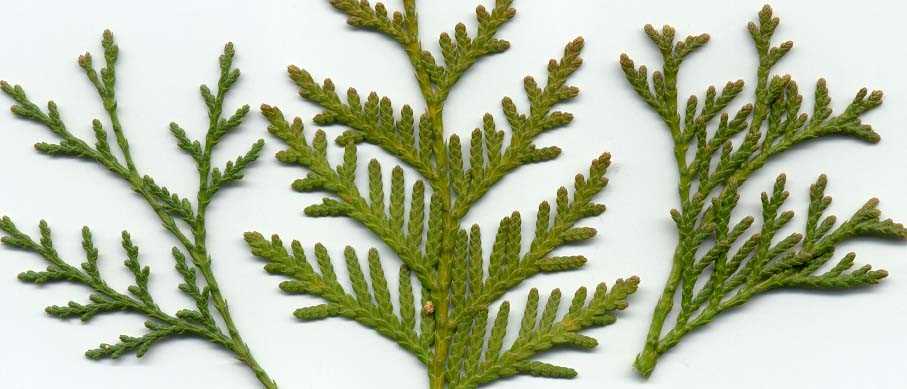
Thuja x ‘Spiralis’ is a unique variety of thuja that has twisted, spiral-shaped foliage. It is a slow-growing evergreen that forms a compact, columnar shape. Thuja x ‘Spiralis’ is an eye-catching plant that can be used as a focal point in the garden.
These are just a few examples of the many types and varieties of thuja available. Each one offers its own distinct features and can be used in a variety of landscaping and garden designs.
Common Types of Thuja
Thuja occidentalis (American Arborvitae)
Thuja occidentalis, also known as the American arborvitae, is one of the most popular types of Thuja. It is native to North America and is highly valued for its dense, evergreen foliage and attractive pyramidal shape. This variety is commonly used as a hedge plant and can grow up to 30 feet in height.
Thuja plicata (Western Red Cedar)

Thuja plicata, commonly known as the Western red cedar, is a large evergreen conifer native to the Pacific Northwest of North America. It is known for its tall, columnar shape and aromatic foliage. This variety is often used in landscaping for screening purposes and can reach heights of up to 200 feet.
Thuja orientalis (Oriental Arborvitae)

Thuja orientalis, also called the Oriental arborvitae, is a small to medium-sized evergreen tree native to East Asia. It has a conical shape and dark green foliage that turns bronze in winter. This variety is commonly used as a specimen tree or in hedges and can grow up to 30 feet in height.
Thuja koraiensis (Korean Arborvitae)
Thuja koraiensis, known as the Korean arborvitae, is a slow-growing evergreen tree native to Korea and parts of China and Russia. It has a rounded shape and dense, dark green foliage. This variety is often used in ornamental gardens or as a windbreak and can reach heights of up to 50 feet.
In addition to these common types, there are also many hybrid varieties of Thuja available, offering a wide range of sizes, shapes, and foliage colors to suit different landscaping needs.
Questions and Answers:
What is Thuja and what are its uses?
Thuja is a genus of evergreen coniferous trees and shrubs in the cypress family. It is commonly used as a decorative plant in gardens and landscapes due to its attractive foliage and compact growth habit.
How do you grow Thuja?
Thuja can be grown from seeds or propagated from cuttings. It thrives in well-drained soil and requires full sun to partial shade. Regular watering and occasional pruning are also necessary to ensure proper growth.
What are the different types and varieties of Thuja?
Some popular types of Thuja include Thuja occidentalis (Eastern arborvitae), Thuja plicata (Western red cedar), and Thuja standishii (Japanese arborvitae). There are also various cultivars and varieties of Thuja, such as ‘Emerald Green’, ‘Golden Tuffet’, and ‘Smaragd’.
Is Thuja resistant to pests and diseases?
Thuja is generally resistant to many common pests and diseases. However, it can sometimes be susceptible to diseases such as cedar apple rust and pest infestations like bagworms. Regular inspection and proper care can help prevent and manage these issues.
How fast does Thuja grow?
The growth rate of Thuja can vary depending on the species and growing conditions. On average, Thuja can grow anywhere from 6 to 12 inches per year. Some faster-growing varieties, such as ‘Green Giant’, can even reach heights of 3 feet or more in a single year.
